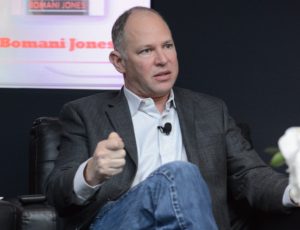Podcasts are growing at a rapid rate, but the ability to monetize them has yet to catch up. In terms of sponsors buying ad space, terrestrial radio and linear television are still the focal point, but the connection hosts build with listeners through podcasts should have clients viewing the digital medium as a lucrative opportunity.
ESPN held an event “Podcast Day for Advertisers” last week, a chance for elite hosts to discuss their goals when creating a digital show. Traug Keller, Senior Vice President of ESPN Audio, along with a panel of hosts featuring Bomani Jones, Matthew Berry, Katie Nolan and Jody Avirgan were on hand and offered a variety of powerful statistics; 48 million people listen to podcasts each week, 80% of those listen to most or all of a podcast, over half of all Americans listen to digital audio streaming each week, along with other facts in an attempt to explain why podcasts are a worthwhile investment for sponsors.
The numbers are great, but what caught my attention most was listening to the network’s hosts explain the connection they build with podcast listeners. A podcast listener isn’t consuming the program because they never changed the radio dial from a previous show, they’re not listening to have background noise or because they accidentally stumbled on to the podcast. Consumers sample a podcast because they sought out that specific program. That means they’re more likely to be fully engaged. Knowing the listener specifically chose that show, allows hosts’ the freedom to be more experimental.
During the event, Katie Nolan said she views her podcast “as my chance to talk to you the way I would talk to my friends.” Nolan continued, “when it was Garbage Time, we would do our podcast right after we were done filming the show, it was the time to be like okay…we scripted, worried about that all week and now I just want to actually talk about the things we didn’t have time to get to, or a weird angle about something. Its more conversational and more of a chance to discuss things that might only matter to me or might end up being interesting to other people.”
Although hosts aren’t interacting with live callers on a podcast the way they do for local talk radio, it’s still an intimate medium that keeps listeners engaged, even during advertisements.
Nolan explained how her podcast attempts to distribute live reads in creative ways, keeping listeners from jumping ahead. “Every time we did them (live reads) I would do them in a different style, but I wouldn’t be told beforehand, so it became an improv exercise. For example, I could be told…’you’re someone who lives in Georgia, works in construction and is on the job right now,’ so that’s how I would read the copy and I’m really bad at it…::Laughs:: but what we found was people stayed listening through the ad because we made it sound different and if the listener misses what happened in the read they might miss a call back later in the podcast and no one wants to feel like an outsider…so we have fun making it interesting.”
While Nolan’s way of giving live reads might be unconventional and corny to some degree, it’s also proved to be successful. Nolan said her podcast has received voicemails from listeners reciting the show’s live reads and commercials.
Fantasy expert and host of the Pro Football Focus podcast, Matthew Berry, supported the sentiment of listeners connecting with ads during their podcast in a surprising way. Berry said, “at our live shows we have a tradition where we pull people out of the audience to do the live read. At our last one we had someone come up to do the Blue Apron one and he said ‘I don’t need the script.’ He recited it word for word and crushed it, so listeners engage with every aspect of the podcast and it’s an unbelievable thing.”
Hosts put a lot of time and effort into their content, which is specifically true for ESPN’s 30 for 30 podcast. Host Jody Avirgan said they will sometimes spend a full week on just one minute of their docks. Often, the first thing a listener will hear when subscribing to an episode of their podcast is an advertisement. If they put a week’s worth of time into one minute of audio, then a one minute advertisement should be given the same attention.
Avirgan’s goal is to make ads sound as compelling and engaging as the podcast itself. Jody recently took the time to interview the CEO of a sponsor, turning a commercial into a narrative offering back and forth, along with clips and sound design to make the ad fit the quality of the show.
Listeners are locked into podcasts because most of them are not casual consumers. By offering creative advertisements, podcasts are able to keep a larger percentage of its listeners engaged in a way terrestrial radio has trouble doing.
After the panel spoke, I had the opportunity to discuss podcasting one on one with popular hosts Bomani Jones and Matthew Berry, and SVP of ESPN Audio Traug Keller.
Traug Keller
BC: Do you view podcasts and terrestrial radio as the same target audience?
TK: The target audience are people with ears. I think podcasting is just putting our content in one more place for people to have access to it. It isn’t about one or the other, it’s about the collective. We just want to be anywhere there are listening opportunities.
BC: Does podcasting compete with terrestrial radio?
TK: I think everything competes with people’s time. You can say yes to a degree, but we want to keep people in our universe rather than leave the universe. Maybe they’re driving home from work and they want to listen to The Michael Kay Show live, there’s an inherent piece of local radio being live, but then they’re on the treadmill and they want to listen to the 30 for 30 podcast, so we want to be available during all listening opportunities.
BC: How does that work with a program like The Michael Kay Show where they have the live radio show, but then it’s also posted as a podcast after? Are you hoping to get those podcast listeners and drive them back to terrestrial radio? Do you worry that you’re pushing listeners away from live content by offering that show as a podcast?
TK: I don’t think so. It’s recognizing, especially in this digital world, that the listener is in charge, the consumer is in charge. To try to make something where they can’t be in charge is a mistake. The Michael Kay Show for instance, if you can listen to it live you will, but if you’re working and you can’t, the podcast will be there for you. The Dan Le Batard Show is a good example of that, it’s on from ten to one so a lot of people are at work, but they download it and listen to the podcast later. We’re all competing for people’s time and we have to make it as convenient and easy for people to access our content.
BC: With ratings so important to terrestrial radio, how do you track podcasts and factor those in to a radio show’s listenership?
TK: We add it all together. When we look at our usage and listening, we take terrestrial ratings, podcast downloads, streaming numbers, satellite information, smart speaker information, we look at it as a collective and say how are we doing?
BC: You had an incredibly talented panel of podcast hosts sitting on stage today, but do you also look at podcast space as offering you the ability to develop and groom hosts to bring them to terrestrial radio?
TK: Absolutely. That’s happened in the past and I know it’s going to happen again. It definitely gives people a chance to get some of their 10,000 hours in.
Bomani Jones
BC: One of the main topics discussed was building the connection with the listener, you’re someone who has done local radio, national radio, national television and podcasts, how do you build that connection through a pre-recorded podcast.
BJ: Interaction is obviously the easiest way to connect, that’s harder to do when you’re working national. When you’re local and doing something small it’s much easier to do that, it’s hard working at an operation like this, to have that true sense of intimacy with the listeners. So the best that I can try to do is be as accessible as possible with the listeners. For example, with the podcast we’ll have a voicemail set up to allow people to participate, but that’s a great challenge of when the operation gets to a larger scope with a broader audience. How do you continue to make people feel like they’re really really involved? But I try to be accessible and I try to make the content as much as possible, align with the lives that the listeners are living.
BC: How do you develop topics nationally? Are there times you can’t focus on what you want to talk about, but need to focus on what will appeal to the largest audience with the hot topic nationally?
BJ: Oh yea! All the time…
I would love to talk about Texas football for an hour a day every week, but I’m the only one that really wants to hear that in the space that I’m in. The people that want to hear about Texas football aren’t coming to a show that’s going to talk about it every now and then.
As much as people complain about the LeBron talk, I think we can talk about LeBron three hours a day, 365 days a year and never run out of anything to talk about. It gets corny if you’re trying to sound like everybody else. The trick is figuring out your way of talking about it that separates yourself from everyone else who is talking about the same thing. If you’re doing local, the same thing will apply, but it’s just a different set of hot topics. If people are by and large coming to sports radio, that’s the first place they’re going, then after that you have people that are coming for you and you figure out your way to give them the hot topics. Whether it’s local or national, the topics are going to usually be dictated by what the people want to hear.
BC: If you had a hot take on a lesser topic that no one is talking about, you could make it a focal point in local radio, but with a podcast, or national you need to go to a topic that everyone is talking about even if you’re not as hot on it.
BJ: If I’m doing local radio I still need to consider what everyone is talking about, if North Carolina North Carolina State play over the weekend, Monday is not the time to say…hey guys I have this new idea for you. It’s just a different set of things that you need to focus on when doing local radio. The difference with local radio is it’s easier to build that sense of affinity because you have more in common and know more about your listeners.
BC: Do you miss local radio?
BJ: I love doing local radio. I did local radio in a place that’s unique though because it’s a college area with three schools. With local radio, you’re supposed to be a fan of a team, but that’s a dangerous game to play when you’re dealing with two, let alone three teams, in how you position yourself and everything else. With three teams you have so many different things and ideas and people coming together. It is more fun to do this with people that you have a connection to. If you really love doing radio, you don’t just love it so you can hear your own voice, you love it because of the relationship you can build with the people that are listening to you and that’s what we try to do with the podcast.
BC: Who do you consider your target audience?
BJ: I think my target audience is really just people that go to work. The commonality that I try to approach with people is the fact that we all have jobs, we all have bosses, we all have the things that come with that and we’re talking about people at their jobs, with their bosses and dealing with that. That’s where I go with it, but I don’t have one particular person in mind that I think about as far as listening to my show. But I have a broad enough set of experiences that I can talk about topics that may seem inaccessible to someone, but find a connection that makes them say oh okay, now I get this.
BC: Is the podcast used to reach a different audience and get new listeners? Or is it even used to get listeners and drive them to terrestrial radio?
BJ: It depends. When I did the terrestrial radio show that was then converted to a podcast it was the same content going back and forth, but I always look at it as the company is making the decisions as to where they want people to listen. In the moment of making it, I’m creating it for radio and then I think it works for a podcast when it’s done, but the focus was how do we serve the goals of the radio station because that’s making the most money.
But if you’re doing a podcast and a radio show and they are separate, the podcast is your die-hard audience, that’s the people that are opting in to you. That’s where you take your deeper dives, you can stretch out and tell more inside jokes because these are the people that are coming to find you specifically, the people listening on the radio are by and large coming to find the radio station so it’s different.
BC: With the podcast, do you ever have to break yourself out of the mode of just talking to yourself and forgetting that there will be an audience?
BJ: No, I still feel like I’m on the radio, the approach of who I’m talking to hasn’t changed. The thing I need to snap myself out of is being attached to what the top stories of the day are. I don’t have to do that anymore and it’s not wise to do that anymore because that stuff rotates so fast and by the time someone gets to it in this on-demand place, that thing might not even be worth talking about. That’s the part I’m having to snap myself out of, that mindset of programming it like a radio show because how I know how to program audio content is like a radio show.
Matthew Berry
BC: Let’s go back to the 90s, you’re writing for sitcoms and movies compared to what you’re doing now, fantasy sports wasn’t popular, podcasts weren’t invented yet, so how about just the rapid growth of fantasy sports in the last 15-20 years.
MB: Yea, it’s been amazing. In the mid-90’s as you referenced, I was writing for television and movies and gave up what a lot of people would look at as “Whoa! You’re a TV and movie writer!” I was making decent money and gave it all up to pursue a career in fantasy sports which I think a lot of people at that time were like “wait…what?”
For me, it was two-fold, number one that was my passion, it’s what made me happy and I chased happiness. But I also felt, you know what? I’m not weird…the things that I like…I like Springsteen, I like super-hero movies, I like pizza, it’s all pretty main stream, it’s not weird and obscure stuff…and I also really like fantasy sports. So if I like it, my suspicion was that as more people became aware of the game, they’ll enjoy it to. While I don’t think I ever imagined it being as big as it is now, I always knew it would get more popular as people learned about it because it’s super fun and we live in a country that loves to do fun things.
BC: Do you think of fantasy sports as being a form of gambling?
MB: No, I do not.
BC: So you don’t think gambling being legalized will have any effect on fantasy sports?
MB: No, I think there’s a very loose connection in that both fantasy sports and gambling give you rooting interests in games you might not care about. Other than that, there really aren’t any similarities. Fantasy sports, the kind that I focus on, season long fantasy sports, it’s about camaraderie, competition among friends, having a good time, creating and rostering a team, making trades, picking up players they’re all very different actions that involve very different research, as opposed to saying I like the Bulls plus three. Sports gambling becoming legal helps in that it increases interest in sports and increased interest in sports are good for every business related to sports, including fantasy sports, but other than that I don’t really see any competition.
Here is the other thing, it’s not as if all of a sudden people are just now able to gamble. It really just means people can step out from the shadows to do it. People have been gambling for years, it’s been a massive business that tons of people were already doing and yet fantasy sports is still very legal. Do I think people that have not gambled before, might do it now that it’s legal? Sure…but ultimately I think we can now just regulate it and bring it out into the open as opposed to something that was going on in corners with whispers and off-shore.
BC: How have you seen your target audience grow over the last ten-years with your podcast? Have you seen it change as more people become interested in fantasy sports?
MB: It’s definitely grown. That’s the thing about fantasy sports, it was always fairly male based, but now, for example, at our last show we had a guy bring his 12 year old daughter. I went up to him and said, “wow we don’t have a lot of people bring their daughter to the show.” He said, “no no…she brought me, I don’t play fantasy sports, she’s the one that plays fantasy and wanted to come here.”
That’s awesome and she’s going to be in our women’s league next year. We’ve seen so much diversity in fantasy sports…grandmas play, kids play, men play, women play, that’s what has been exciting, seeing so many people play from all walks of life, all ages and genders.
Brandon Contes is a freelance writer for BSM. He can be found on Twitter @BrandonContes. To reach him by email click here.

Jason Barrett is the President and Founder of Barrett Media since the company was created in September 2015. Prior to its arrival, JB served as a sports radio programmer, launching brands such as 95.7 The Game in San Francisco, and 101 ESPN in St. Louis. He also spent time programming SportsTalk 950 in Philadelphia, 590 The Fan KFNS in St. Louis, and ESPN 1340/1390 in Poughkeepsie, NY. Jason also worked on-air and behind the scenes in local radio at 101.5 WPDH, WTBQ 1110AM, and WPYX 106.5. He also spent two years on the national stage, producing radio shows for ESPN Radio in Bristol, CT. Among them included the Dan Patrick Show, and GameNight.
You can find JB on Twitter @SportsRadioPD. He’s also reachable by email at Jason@BarrettMedia.com.







